Text And Photos By Noel T. Braymer
Having watched improvements in Rail Passenger service in California over the last 35 years or so, I notice new construction and business happens after rail passenger services improves. Let’s face it, the old pre 1970’s train stations were generally not in the best parts of town. In the past the railroad stations were mostly used for freight business with passenger service as a sideline. But as passenger service improved in California starting in the mid 1970’s, so has the neighborhoods around the stations. This is particularly true when train stations have been transformed into intermodal transportation centers.This is a major selling point for expanding and improving rail passenger service. The local transit agency in Hong Kong is also a major landlord in Hong Kong. The rental income from the property it owns around its stations is its largest source of income. In fact the Hong Kong transit agency makes money based on their income property which is valuable because of their transportation service to these properties. My analogy for years has been that rail service is akin to elevators in a hi-rise building. No one charges passengers to ride the elevator in a hi-rise building to make money. But hi-rise buildings can’t make money without good elevator service.
Major problems in California include traffic congestion, air quality and lack of affordable housing. Improved rail and connecting transit service with increased development around transportation centers will go a long way in solving these problems. Development at the stations with new housing, services and employment would reduce the amount of driving people would need compared to today. This isn’t really new. Major cities around the world function with higher densities and have excellent alternatives to auto travel which work well. People also walk and bike ride more too which reduces the need for driving. So let’s take a look at what has happened in Southern California around transportation centers when rail service was improved. Since I live in Southern California, that where I’ve seen the progress the most. Here are some examples of what has happened and what is planned.
Oceanside was one of, if not the first place to build a new rail centered transportation center after World War II in this country. Its history goes back even before the creation of Amtrak. After a 13 year effort it was finally opened to the public in 1984. Actually phase one was opened in 1984. Since 1984 there have been many improvements and new improvements are still ongoing. A major factor behind building the Oceanside Transit Center was as a way to redevelop downtown Oceanside. The downtown area around the old train station was rundown with crime problems and the property around the nearby beach and pier was undervalued. The city and local chamber of commerce planned with the new transit center, other development would follow making Oceanside a seaside resort which would increase local property values and the city’s tax base. This is what happened.
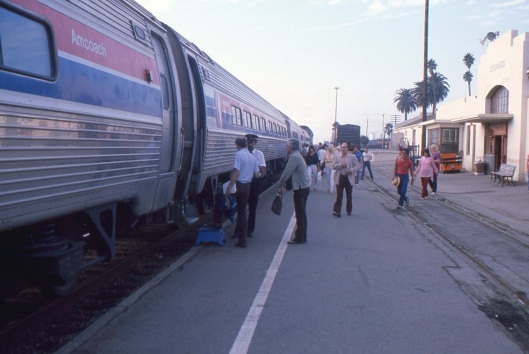
Oceanside California in late 1983 at the “temporary” World War II ATSF station. This station was also part of a freight yard.
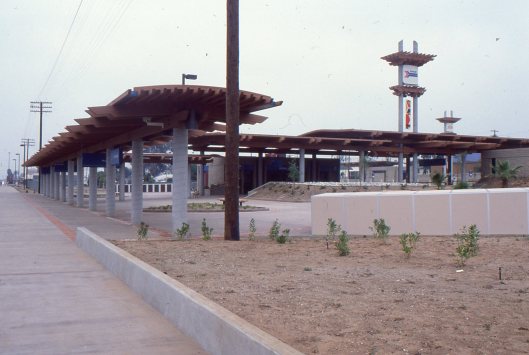
This is the almost finished Oceanside Transit Center in late 1983,it was build next to the old ATSF station. In 1984 it had only one passenger platform of the 2 tracks at the station. But it did also have intercity and local transit bus service.
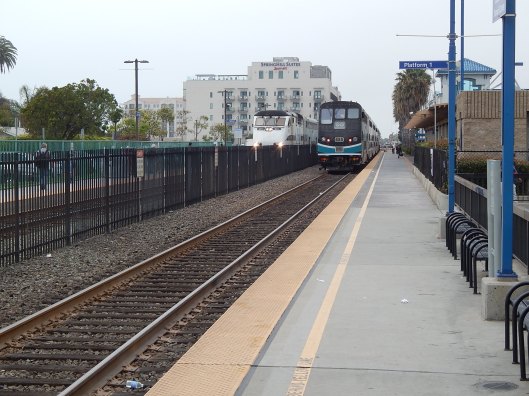
This is a recent photo of the Oceanside Transit Center. The 2 large building in the background are resort hotels. The station has a tunnel under the tracks to serve the platform on the left hand side and for walking to the nearby beach. Besides Amtrak, Oceanside is served by Metrolink and Coaster Trains was well as DMU service to Escondido 20 miles away. A third track and platform is under construction to the south. This picture is viewing north.
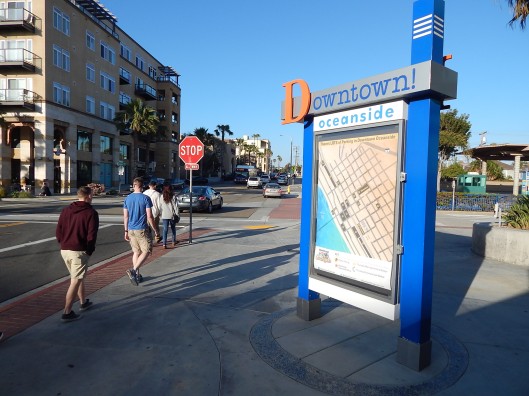
This is the view of some of the new construction built from the edge of the Oceanside Transit Center
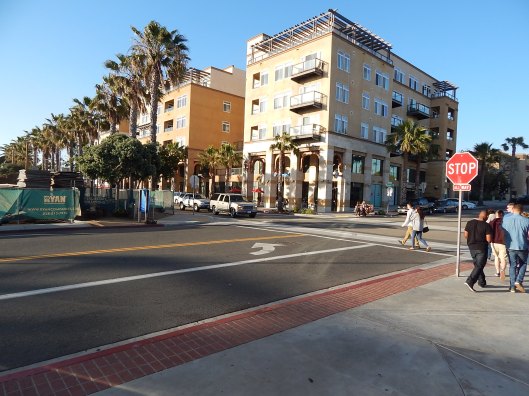
This is a closer view across the street from the Oceanside Transit Center. The tall building are housing on the top floors with retail businesses on the bottom floor. Across from this building when this picture was taken is a fenced off construction site.

This is an old picture of the Santa Fe Depot in San Diego from the roughly the late 70’s to early 80’s. Not many tall or new building in the area.

This is a picture from the early 90’s of the new light rail “Trolley” tracks recently built to extend rail transit to the Santa Fe Depot.

This is the current view at the Santa Fe Depot in San Diego with Trolley Tracks in the foreground and new tall building in the background and surrounding the Depot in San Diego.

This the location of the then future Santa Ana Transit Center in the mid 1980’s. Many of the features at Oceanside were incorporated by the Santa Ana center.

This is a recent view from the Santa Ana Transit Center of new housing that has been built across the street.

This is at the Fullerton Station. This is the old Fullerton Union Pacific Station which was on the other side of the tracks and some distance from the ATSF Fullerton Station. The old UP Station was moved next to the ATSF station, the site of which has become Fullerton’s transit center. The UP Station was converted in the 1980’s roughly into a restaurant as part of the transit center. There are other new restaurants and other building now in Fullerton by the train station.

This drawing of Los Angeles Union Station is the front cover of a report called “Transforming Los Angeles Union Station”. This is the final report written for LA Metro, the Los Angeles County government body in charge of transportation and owner since 2011 of Union Station. This drawing shows the planned run-through tracks and new hotel planned at the station as well as pedestrian bridges over the station platforms. Across from the main station with the red roof on the other side of the stations tracks are planned new hi-rise office buildings.

This is also from “Transforming Los Angeles Union Station”. This gives some detail into the goals of the development around Union Station.

Reblogged this on The Spline.
LikeLike
For some reason, the State of California must be using the same PR agency as United Air Lines, as this is a fantastic story that has never properly made the headlines re the growth of development, both residential and retail, mobility; all predicated upon quality intercity regional and commuter rail services serving local transportation centers. Not even the political naysayers who moved to kill Caltrain electrification can deny this continuing success story.
The question should be how can this so well constructed template be implemented elsewhere, as in the Midwest, given it would require the cooperation of multiple states currently governed by a recalcitrant crowd indebted to the lobbyists paid to “cap” all forms of rail?
In respect to how California has for so long exemplified the auto culture of America, this is truly a great story. One deficiency to overcome, however, is how to facilitate usage of the LOSSAN line from the Palos Verdes and beach communities? (The last PE line thru Manhattan Beach is an inviolable walking/bike trail.)
LikeLike